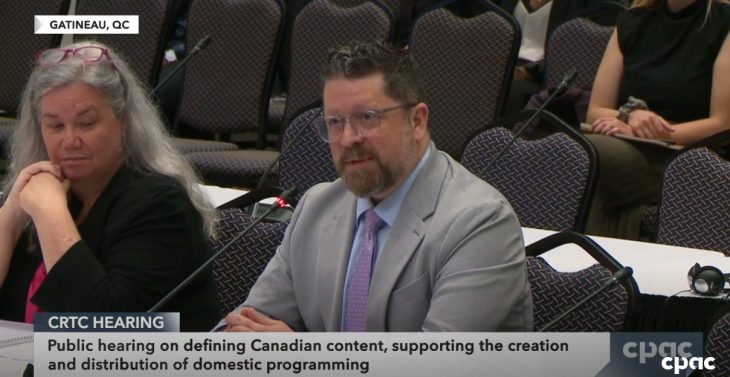
By Ahmad Hathout
Foreign streamers should be made to put money toward Canadian news funds because they are drawing money that used to go to support it out of the system, the Canadian Association of Broadcasters (CAB) argued on the first day of the CRTC’s hearing on the definition of Canadian content in the audio-visual space Wednesday.
“What the foreign streamers have been able to do is to come in and … take revenues out of Canada,” Kevin Desjardins, president of the trade group that represents the big private broadcasters, told the five-member CRTC panel about the advertising and subscriber revenues that the private broadcasters, struggling with the cord cutting phenomenon, have lost.
“Those were the sorts of things that helped to ensure that news was one of the pieces that could get produced. So again, whether if they are doing news themselves, I think that by and large Canadians probably would not put a level of trust and confidence in news that was produced by a foreign entity, but at the same time, they are taking some of the resources out of the system that help to support news.
“And on that level, that is the rationale for them having to put money back into news.”
Desjardins said there is a misunderstanding from foreign streamers about how news contributions are circulated. He said the majority of the broadcasters who are forced to contribute to the Independent Local News Fund (ILNF) – money from which is then distributed by the CAB – do not actually produce news, which he said undermines the streamer argument that they should not be forced to contribute to something they do not produce.
Desjardins was speaking to the argument put forward by the Canadian affiliate of the Motion Picture Association (MPA) – the trade group that represents Netflix, Paramount, Pluto, and Crunchyroll – which will likely argue exactly that to the CRTC later this week and for certain next month in front of the Federal Court of Appeal: that their members do not produce or derive any value from news and therefore shouldn’t be forced to direct a portion of their Canadian revenues to support said programming.
Forcing a portion of that base contribution toward the ILNF was “a significant and important first step,” Tandy Yull, the CAB’s vice president of policy and regulatory affairs, told the panel Wednesday.
At the same time, the CAB said in response to a question about the CRTC possibly incentivizing news production that it isn’t quite sure it would want Netflix, for example, doing news programming, and noted that these streamers should not be able to dip into the news fund.
“I think we’d like to see them reinvest some of the revenue they’re taking out of Canada back into Canadians news production,” Yull said, referring to the news funds.
While the Online News Act provides for new funding through large foreign platforms – specifically Google’s $100 million annual contribution – Desjardins said full-time broadcast journalists are valued at half that of a print journalist, with the program distributing about $7,000 per full-time broadcast journalist per year.
“That’s not enough to help save the system,” he said. “It may be enough to help keep some journalists in newsrooms, but that is not the one and only way to support news.”
One other way to that end, the CAB put forward, is to reduce broadcasters’ regulatory obligations, such as to programs of national interest (PNI), to free up money that they would be forced to put toward drama programming, for example, when they prefer to put that toward news.
“Twenty years ago, if you were to look at the top 20 shows in either Canada or the U.S., you may see dramas and comedies and whatnot,” Desjardins said. “And I think if you take a look at what audiences are seeking out now, it is reality, sports, news – things that drive audiences to live broadcasting.
“So that’s not to say that there isn’t a place for those other categories, but we actually think that the influx of the foreign broadcasters or the foreign online streamers provides more of a venue for that sort of content. It is more likely to be the sort of content that a streamer would be interested in acquiring as opposed to some of those live elements.”
Flexibility is a word used by large private broadcasters who had asked the CRTC to lessen their regulatory obligations on things like PNI spending to compete against foreign streamers.
Because for the CAB, it’s not just about forcing these formerly exempt online platforms to contribute, it’s also about lessening the burden on traditional Canadian broadcasting players to truly level the playing field.
“CAB’s members have distinctive business models and programming strategies, and the contributions that they make to the broadcasting system as a whole must align with those unique approaches,” the CAB said in its opening remarks. “This is why the CAB strongly supports the Commission’s stated approach to tailored conditions of service. We believe that recognizing the differences between the players and focusing on incentives rather than quotas is the best way to achieve the goals of this process.”
Screenshot of CAB President Kevin Desjardins presenting in front of the CRTC on Wednesday



